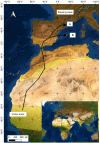High rates of antibodies against Toscana and Sicilian phleboviruses in common quail Coturnix coturnix birds
- PMID: 36687574
- PMCID: PMC9846092
- DOI: 10.3389/fmicb.2022.1091908
High rates of antibodies against Toscana and Sicilian phleboviruses in common quail Coturnix coturnix birds
Abstract
Introduction: Birds are involved natural cycle of a number of vector-borne viruses in both rural and urban areas. Toscana (TOSV) and Sicilian (SFSV) phleboviruses are sandfly-borne viruses in the genus Phlebovirus that can cause diseases in human. However, there is limited information on the role of the birds in sandfly-borne phleboviruses natural cycle and reservoirs ofthese viruses remain unknown.
Methods: In this study, we analyzed Common Quail (Coturnix coturnix) sera from Spain to identify the seroprevalence of these two phleboviruses. We tested respectively, 106 and 110 quail serum against TOSV and SFSV from 2018, 2019, and 2021 from two locations in northern Spain with using virus neutralization test.
Results: We identified high neutralizing antibody rates for SFSV (45.45%) and TOSV (42.45%) with yearly fluctuation.
Discussion: This is the first identification of SFSV and TOSV neutralizing antibodies in wild birds. High seroprevalence rates of TOSV and SFSV in quail birds raises the question whether birds have a role as amplifying hosts in the natural cycle of phleboviruses.
Keywords: Coturnix coturnix; SFSV; TOSV; birds; common quail; phlebovirus; reservoir.
Copyright © 2023 Ayhan, Rodríguez-Teijeiro, López-Roig, Vinyoles, Ferreres, Monastiri, Charrel and Serra-Cobo.
Conflict of interest statement
The authors declare that the research was conducted in the absence of any commercial or financial relationships that could be construed as a potential conflict of interest.
Figures



Similar articles
-
[Serological investigation of phlebovirus exposure in blood donors from the Mediterranean Province of Mersin, Turkey].Mikrobiyol Bul. 2015 Jul;49(3):403-13. doi: 10.5578/mb.9765. Mikrobiyol Bul. 2015. PMID: 26313281 Turkish.
-
Serological association between Leishmania infantum and sand fly fever Sicilian (but not Toscana) virus in sheltered dogs from southern Portugal.Parasit Vectors. 2017 Mar 13;10(1):92. doi: 10.1186/s13071-017-2023-x. Parasit Vectors. 2017. PMID: 28285587 Free PMC article.
-
Neutralization-based seroprevalence of Toscana virus and sandfly fever Sicilian virus in dogs and cats from Portugal.J Gen Virol. 2016 Nov;97(11):2816-2823. doi: 10.1099/jgv.0.000592. Epub 2016 Sep 2. J Gen Virol. 2016. PMID: 27589865
-
Epidemiology of Sandfly-Borne Phleboviruses in North Africa: An Overview.Insects. 2024 Oct 29;15(11):846. doi: 10.3390/insects15110846. Insects. 2024. PMID: 39590445 Free PMC article. Review.
-
Phleboviruses and the Type I Interferon Response.Viruses. 2016 Jun 22;8(6):174. doi: 10.3390/v8060174. Viruses. 2016. PMID: 27338447 Free PMC article. Review.
Cited by
-
Susceptibility of diverse sand fly species to Toscana virus.PLoS Negl Trop Dis. 2025 May 2;19(5):e0013031. doi: 10.1371/journal.pntd.0013031. eCollection 2025 May. PLoS Negl Trop Dis. 2025. PMID: 40315233 Free PMC article.
-
Toscana virus - an emerging Mediterranean arbovirus transmitted by sand flies.J Gen Virol. 2024 Nov;105(11):002045. doi: 10.1099/jgv.0.002045. J Gen Virol. 2024. PMID: 39508743 Free PMC article. Review.
-
Two strains of Toscana virus show different virulence and replication capacity in mice and cell culture models.Virulence. 2025 Dec;16(1):2535470. doi: 10.1080/21505594.2025.2535470. Epub 2025 Jul 22. Virulence. 2025. PMID: 40693587 Free PMC article.
-
Toscana Virus in Wild-Caught Sand Flies in Portugal, Findings from the National Vector Surveillance Network, 2023.Pathogens. 2024 Oct 15;13(10):905. doi: 10.3390/pathogens13100905. Pathogens. 2024. PMID: 39452776 Free PMC article.
-
Seroprevalence of sand fly fever Sicilian virus in blood donors in mainland Portugal.Parasit Vectors. 2025 Jul 5;18(1):261. doi: 10.1186/s13071-025-06885-x. Parasit Vectors. 2025. PMID: 40618143 Free PMC article.
References
-
- Abulreesh H. H., Goulder R., Scott G. W. (2007). Wild birds and human pathogens in the context of ringing and migration. Ring. Migr. 23 193–200. 10.1080/03078698.2007.9674363 - DOI
-
- Alcover M. M., Ballart C., Martín-Sánchez J., Serra T., Castillejo S., Portús M., et al. (2014). Factors influencing the presence of sand flies in Majorca (Balearic Islands, Spain) with special reference to Phlebotomus pernicious, vector of Leishmania infantum. Parasit. Vectors 7 1–12. 10.1186/1756-3305-7-421 - DOI - PMC - PubMed
LinkOut - more resources
Full Text Sources

